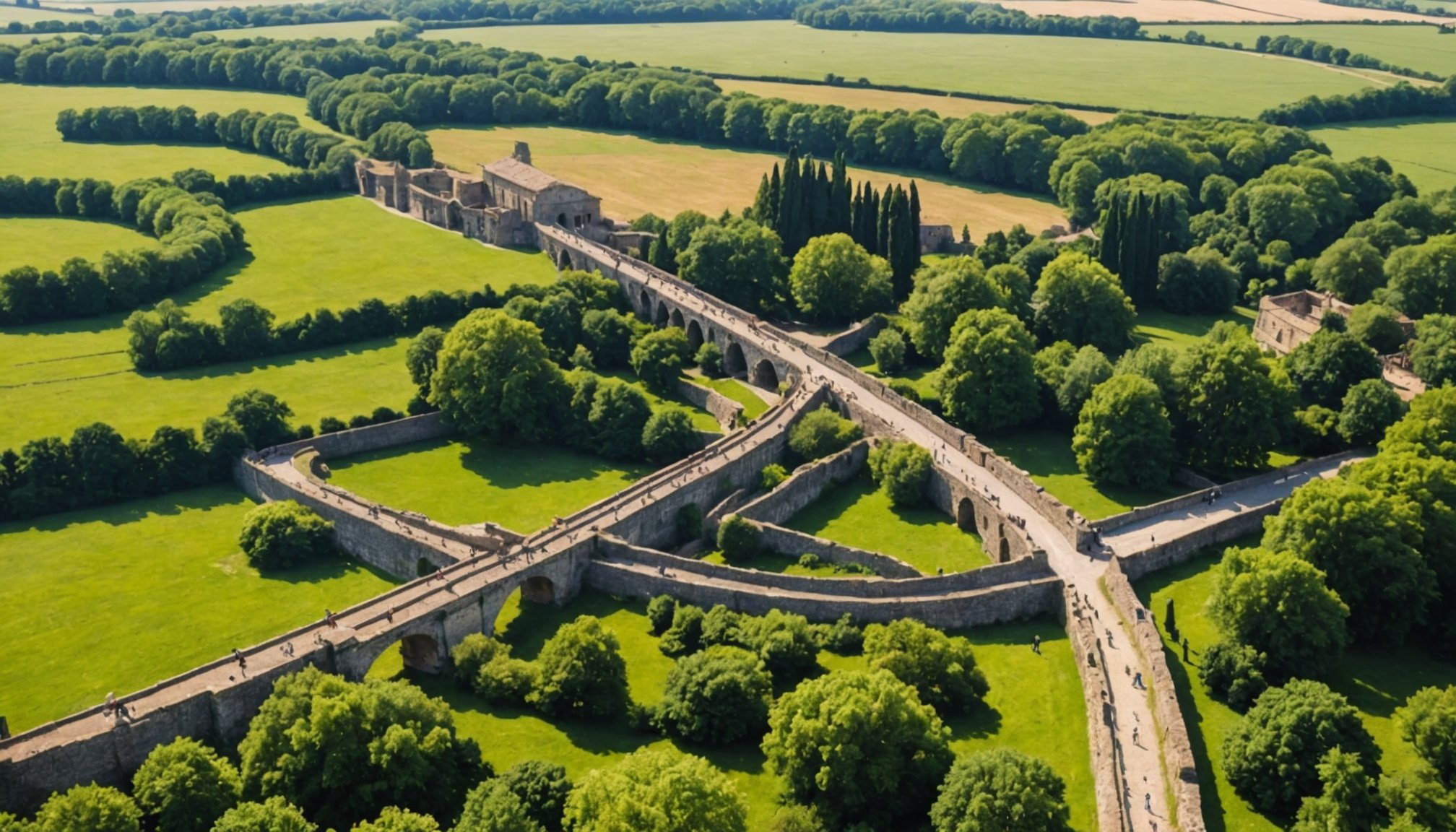Overview of Ancient Roman Roads in the UK
Understanding the historical significance of ancient Roman roads is critical to appreciating the depth of Roman influence in the UK. These roads were instrumental in establishing trade, facilitating military movements, and linking diverse regions.
Ancient Roman roads were constructed with remarkable engineering prowess. Not only did their construction involve meticulous planning, but they were also built to last. The importance of Roman infrastructure lies in its ability to create a unified network that enabled both the swift movement of the Roman legions and the efficient transport of goods. These roads are a testament to a sophisticated system that underpinned the daily working life of Roman Britain.
Have you seen this : Explore the Rich History: Top UK Towns for In-Depth Georgian Era Walking Tours
Notable routes such as Watling Street, Fosse Way, and Ermine Street trace strategic paths across the British landscape. These roads played pivotal roles in connecting vital Roman settlements, thereby positioning the Roman Empire for military and economic success. They enhanced trade by allowing for more straightforward movement of goods and services, significantly impacting commerce and societal interactions.
In summary, these Roman roads not only highlight Roman engineering excellence but also underscore the long-standing impact of Roman strategies on Britain’s development and prosperity. Their enduring legacy offers insights into this transformative period still relevant in understanding the UK’s historical framework.
Also to see : Journey through the edwardian era: uncover the enchantment of heritage train adventures
Must-See Guided Tours of Roman Roads
Embarking on guided tours of Roman roads provides a fascinating journey through history, showcasing the ancient pathways that once connected the Roman Empire. These excursions not only illuminate the ingenuity of Roman engineering but also reveal historical narratives woven into the British landscape.
There are numerous popular tours that explore these historical tours in the UK. For an immersive experience, consider joining a tour of Watling Street. This famous road, rich with ancient tales, takes you through areas abundant in historical artefacts and Roman relics.
For those interested in the Roman military’s influence, a guided tour along Ermine Street offers insights into its role in strategic military movements. Alternatively, participate in excursions exploring the Fosse Way, renowned for its pivotal role in connecting significant Roman settlements.
Each tour possesses unique features tailored to different interests and regions. Whether it’s the narrative-focused experiences of Watling Street or the visually rich journey along the Fosse Way, each excursion provides diverse perspectives into ancient Roman infrastructure. Ranging from a few hours to full-day trips, these tours accommodate a variety of schedules, ensuring each participant can savour an unforgettable, educational experience of Roman road excursions.
Detailed Profiles of Key Roman Roads
Exploring the key Roman roads in the UK offers a deeper understanding of their historical significance. Each road tells a unique story, reflecting its importance during Roman times.
Watling Street
Watling Street is one of the most intriguing of the Roman routes. Historically, it connected strategic locations from Dover to Wroxeter. Visitors can embark on guided tours that reimagine its role as a bustling trade and military highway. These tours often highlight the seamless integration of history and nature, emphasizing the enduring influence of Roman ingenuity.
Fosse Way
Running diagonally across England, the Fosse Way was pivotal in linking the southwest to the northeast. Its route provides a fascinating avenue for Roman road exploration. Tours here can delve into its role in aligning disparate regions, exposing travellers to the vibrant topography and historical landmarks.
Ermine Street
Renowned for its strategic significance, Ermine Street links London to York. This major road facilitated military manoeuvres and economic exchanges, which are often explored in featured tours. Participants usually recount experiences enriched by vivid historical narratives and knowledgeable guides, offering memorable insights into one of the most notable Roman routes in the UK.
Practical Information for Tourists
Exploring Roman road tours combines historical exploration with modern travel conveniences. To ensure a superb experience, consider these practical tips.
Travel Logistics & Costs
Most guided tours of Roman roads in the UK generally last between a few hours and a full day. Prices vary depending on the length and complexity of the tour, ranging from £30 to £150 per person. It’s advisable to book in advance to secure spots, as many guided tours tend to fill up quickly, especially during peak travel seasons.
Maximising Your Experience
To make the most of your Roman road excursions, prepare accordingly. Comfortable walking shoes and weather-appropriate clothing are essential, given the outdoor nature of the tours. Bringing a camera can also be rewarding, as the routes offer stunning landscapes and striking historical vistas.
Booking & Resources
Many tour operators offer online booking services for planning Roman road tours. Checking traveler reviews can provide insight into the quality of the tours and which ones match your preferences. Some reputable operators even offer expert-led tours, adding depth to the historical narratives.
By leveraging these tips, you can deepen your appreciation for ancient Roman roads with ease and enthusiasm.
Visitor Reviews and Testimonials
Exploring the experiences of guided tours offers invaluable insights into what awaits history enthusiasts on Roman road adventures. Participants often share glowing user testimonials, emphasizing the richness of Roman road tour reviews.
Visitors frequently applaud the knowledgeable guides for their engaging narratives. As one traveller put it, “The guide’s passion for history made the tour unforgettable. They truly brought the ancient roads to life.”
Participants also highlight the meticulous planning of the tours, appreciating how each excursion is tailored to provide a comprehensive dive into Roman history. “The seamless blend of storytelling and exploration made it an enriching experience,” notes another reviewer.
Notably, many reviews emphasize the tours’ ability to connect the dots between Roman infrastructure and present-day landscapes. While positive feedback prevails, a few travellers suggest enhancements, primarily regarding pacing. “A longer visit at key sites would be welcome,” mentions a participant, suggesting a deeper dive into particular historical aspects.
Overall, these user testimonials underline the transformative impact of walking in the footprints of Roman legions, illustrating the enduring appeal of these ancient pathways. Whether for their educational value or sheer fascination, the commendations reflect a widespread appreciation for these guided tours.
Visuals and Maps of Roman Roads
Visual aids significantly enhance one’s understanding of ancient Roman roads. An engaging guide to Roman road exploration is incomplete without precise maps, which offer a clear view of the remarkable network that once crisscrossed the UK.
Navigating Roman paths is made easier with detailed maps of Roman routes. These maps not only display the historical roads but also inform enthusiasts on the best paths to explore today. They provide an intuitive sense of direction, helping visitors imagine the strategic reach of the Roman Empire. Engaging with these maps is akin to holding a relic of Roman infrastructure, connecting the past to the present.
Visual aids for Roman roads also include captivating photographs from guided tours. These visuals depict the landscape once traversed by legions, adorned with remnants of Roman engineering. Photographic highlights play an essential role in drawing potential visitors, offering narrative glimpses of historical tours. They show both natural beauty and archaeological significance.
For an optimal experience, potential visitors should consult recommended resources. These include online platforms, which provide interactive maps facilitating discovery. With the aid of these visual tools, enthusiasts gain deeper insights into the importance of Roman infrastructure, enriching any journey back in time.





